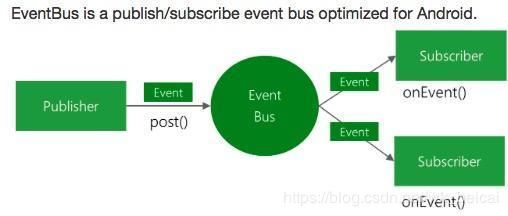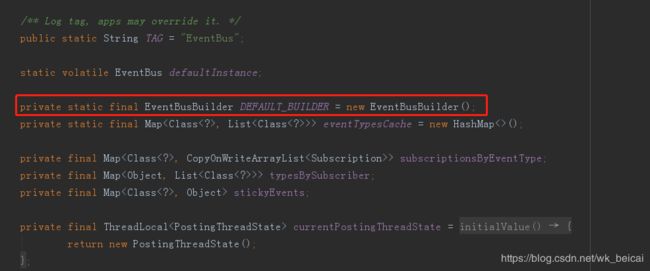EventBus内部是如何实现的? 让我们爱不释手
简言:
相信大家都使用过EventBus,用起来真的是奥利给啊,使用简单,开销还小,这种异步框架真的是让人爱不释手啊,当然了,有一大部分人更加喜欢Rxjava这个框架,毕竟这个框架更NB, 但是今天得主角不是Rxjava,是EventBus,带大家看看他的内部实现是什么?当然在讲源码之前,还是先介绍一下EventBus,我保证,只是介绍啊, 毕竟我也不想啰嗦。。。
1.简介
EvenBus是一个android端优化的消息总线,简化了应用程序内各组件,组件与后台线程间的通信,比如请求网络,等网络返回时通过Handler或者BroadCast通知UI,两个Fragement之间需要通过listener通信,这些需求都可以通过Evenbus实现;
evenBus是一款针对 android 优化的发布/订阅事件总线。主要功能是代替Intent handler Broacaset 在fragement activity
service线程之间的传递消息,优点是开销小,代码更优雅,以及将发送者和接收者解耦.
2.基本的使用:
1,自定义一个类,可以是空类;
2.在要接收消息的页面注册
3.发送消息
4.接收消息的页面实现(共有四个函数,各功能不同)
5.解除注册
3.EventBus的流程 (如图:官网找的)
publisher是一个发布器,然后将我们的事件Event通过post()方法发送到EventBus的主线当中,然后在这个EventBus的主线中,会通过事件(Event)类型匹配相应的订阅者 Subscriber。
4.源码分析(EventBus)
@Override
protected void onCreate(Bundle savedInstanceState) {
super.onCreate(savedInstanceState);
setContentView(R.layout.activity_main2);
findViewById(R.id.btn).setOnClickListener(new View.OnClickListener() {
@Override
public void onClick(View v) {
//发送消息
EventBus.getDefault().post(new MyEvents("hello eventbus"));
}
});
}
@Override
protected void onStart() {
super.onStart();
//注册EventBus
EventBus.getDefault().register(this);
}
@Override
protected void onStop() {
super.onStop();
//注销EventBus
EventBus.getDefault().unregister(this);
}
@Subscribe(threadMode = ThreadMode.MAIN)
public void onMessageEvent(MyEvents events){
Toast.makeText(this,events.message,Toast.LENGTH_SHORT).show();
}这个是Event的使用类,我们看在使用EventBus时,无论注册还是注销发送消息,都有getDefault()这个方法,所以我们先看看这个getDefault方法实现了什么?
/** Convenience singleton for apps using a process-wide EventBus instance. */
public static EventBus getDefault() {
if (defaultInstance == null) {
synchronized (EventBus.class) {
if (defaultInstance == null) {
defaultInstance = new EventBus();
}
}
}
return defaultInstance;
}
public static EventBusBuilder builder() {
return new EventBusBuilder();
}
/** For unit test primarily. */
public static void clearCaches() {
SubscriberMethodFinder.clearCaches();
eventTypesCache.clear();
}
/**
* Creates a new EventBus instance; each instance is a separate scope in which events are delivered. To use a
* central bus, consider {@link #getDefault()}.
*/
public EventBus() {
this(DEFAULT_BUILDER);
}这里没有什么可介绍的,这是一个单例模式,我们关注一下这个EventBus的构造函数,DEFAULT_BUILDER,我们跟进去看一下:
我们可以看出,这个EventBus最终是构建者模式来创建对象的。我们看看他是如何创建的,
EventBus(EventBusBuilder builder) {
subscriptionsByEventType = new HashMap<>();
typesBySubscriber = new HashMap<>();
stickyEvents = new ConcurrentHashMap<>();
mainThreadPoster = new HandlerPoster(this, Looper.getMainLooper(), 10);
backgroundPoster = new BackgroundPoster(this);
asyncPoster = new AsyncPoster(this);
indexCount = builder.subscriberInfoIndexes != null ? builder.subscriberInfoIndexes.size() : 0;
subscriberMethodFinder = new SubscriberMethodFinder(builder.subscriberInfoIndexes,
builder.strictMethodVerification, builder.ignoreGeneratedIndex);
logSubscriberExceptions = builder.logSubscriberExceptions;
logNoSubscriberMessages = builder.logNoSubscriberMessages;
sendSubscriberExceptionEvent = builder.sendSubscriberExceptionEvent;
sendNoSubscriberEvent = builder.sendNoSubscriberEvent;
throwSubscriberException = builder.throwSubscriberException;
eventInheritance = builder.eventInheritance;
executorService = builder.executorService;
} subscriptionsByEventType = new HashMap<>();
typesBySubscriber = new HashMap<>();
stickyEvents = new ConcurrentHashMap<>();
这三个HashMap,都是做什么?
第一个:它是以Event为key,subscript为value,当发送Event时,都可以通过这个HashMap找到对应订阅者。
第二个:它是以Subscriber为key,event为value,当我们做反注册的时候都会操作这个hashMap
第三个:这个是维护的粘性事件,我之前讲过粘性事件的定义,这里就不追溯了。
mainThreadPoster = new HandlerPoster(this, Looper.getMainLooper(), 10);
backgroundPoster = new BackgroundPoster(this);
asyncPoster = new AsyncPoster(this);
我们在看看这三个post(重要)
1)HandlerPoster:我们看参数,传递的是主线程的Looper,是handler现实的,我们追进去看看handerPoster做了什么?
final class HandlerPoster extends Handler {
private final PendingPostQueue queue;
private final int maxMillisInsideHandleMessage;
private final EventBus eventBus;
private boolean handlerActive;
HandlerPoster(EventBus eventBus, Looper looper, int maxMillisInsideHandleMessage) {
super(looper);
this.eventBus = eventBus;
this.maxMillisInsideHandleMessage = maxMillisInsideHandleMessage;
queue = new PendingPostQueue();
}
void enqueue(Subscription subscription, Object event) {
PendingPost pendingPost = PendingPost.obtainPendingPost(subscription, event);
synchronized (this) {
queue.enqueue(pendingPost);
if (!handlerActive) {
handlerActive = true;
if (!sendMessage(obtainMessage())) {
throw new EventBusException("Could not send handler message");
}
}
}
}
@Override
public void handleMessage(Message msg) {
boolean rescheduled = false;
try {
long started = SystemClock.uptimeMillis();
while (true) {
PendingPost pendingPost = queue.poll();
if (pendingPost == null) {
synchronized (this) {
// Check again, this time in synchronized
pendingPost = queue.poll();
if (pendingPost == null) {
handlerActive = false;
return;
}
}
}
eventBus.invokeSubscriber(pendingPost);
long timeInMethod = SystemClock.uptimeMillis() - started;
if (timeInMethod >= maxMillisInsideHandleMessage) {
if (!sendMessage(obtainMessage())) {
throw new EventBusException("Could not send handler message");
}
rescheduled = true;
return;
}
}
} finally {
handlerActive = rescheduled;
}
}
}这个HandlerPoser继承Handler,
PendingPostQueue queue; 这是一个队列
int maxMillisInsideHandleMessage; post这个事件在hanlder中最大的时间值
EventBus eventBus;
handlerActive; 他标识的是是否运行起来了
我们关注一下handleMessage方法做了什么?
通过do,while这个循环,从队列中获取数据,并调用eventBus,invokeSubscriber()分发事件,每分发完一次事件,就对比一下时间,判断这个时间,与上边定义的最大时间值,做比较,如果大于就跳出循环。
2)backgroundPoster (处理后台操作的)
final class BackgroundPoster implements Runnable {
private final PendingPostQueue queue;
private final EventBus eventBus;
private volatile boolean executorRunning;
BackgroundPoster(EventBus eventBus) {
this.eventBus = eventBus;
queue = new PendingPostQueue();
}
public void enqueue(Subscription subscription, Object event) {
PendingPost pendingPost = PendingPost.obtainPendingPost(subscription, event);
synchronized (this) {
queue.enqueue(pendingPost);
if (!executorRunning) {
executorRunning = true;
eventBus.getExecutorService().execute(this);
}
}
}
@Override
public void run() {
try {
try {
while (true) {
PendingPost pendingPost = queue.poll(1000);
if (pendingPost == null) {
synchronized (this) {
// Check again, this time in synchronized
pendingPost = queue.poll();
if (pendingPost == null) {
executorRunning = false;
return;
}
}
}
eventBus.invokeSubscriber(pendingPost);
}
} catch (InterruptedException e) {
Log.w("Event", Thread.currentThread().getName() + " was interruppted", e);
}
} finally {
executorRunning = false;
}
}
}他实现的是Runnalbe,我们直接看他的run()方法:run()主要是不断的从我们队列中获取消息,然后通过invokeSubscruber进行事件分发。直到取完为止。
3)asyncPoster
class AsyncPoster implements Runnable {
private final PendingPostQueue queue;
private final EventBus eventBus;
AsyncPoster(EventBus eventBus) {
this.eventBus = eventBus;
queue = new PendingPostQueue();
}
public void enqueue(Subscription subscription, Object event) {
PendingPost pendingPost = PendingPost.obtainPendingPost(subscription, event);
queue.enqueue(pendingPost);
eventBus.getExecutorService().execute(this);
}
@Override
public void run() {
PendingPost pendingPost = queue.poll();
if(pendingPost == null) {
throw new IllegalStateException("No pending post available");
}
eventBus.invokeSubscriber(pendingPost);
}
}
它也是实现的Runnable,
他的run方法,是获取队列中的一个,进行事件分发,与上边的post是不同的,
上边三个post是EventBus中最核心的类,
3.subscriberMethodFinder(这个也是重要的,他是注解的找寻器)
二,关于注解的分析
@Subscribe(threadMode = ThreadMode.MAIN)
public void onMessageEvent(MyEvents events){
Toast.makeText(this,events.message,Toast.LENGTH_SHORT).show();
}我们还是看一下@Subscribe的源码:
@Documented
@Retention(RetentionPolicy.RUNTIME)
@Target({ElementType.METHOD})
public @interface Subscribe {
ThreadMode threadMode() default ThreadMode.POSTING;
/**
* If true, delivers the most recent sticky event (posted with
* {@link EventBus#postSticky(Object)}) to this subscriber (if event available).
*/
boolean sticky() default false;
/** Subscriber priority to influence the order of event delivery.
* Within the same delivery thread ({@link ThreadMode}), higher priority subscribers will receive events before
* others with a lower priority. The default priority is 0. Note: the priority does *NOT* affect the order of
* delivery among subscribers with different {@link ThreadMode}s! */
int priority() default 0;
}
ThreadMode 线程模式。这个是非常重要的,我们分析一下:
public enum ThreadMode {
POSTING,
MAIN,
BACKGROUND,
ASYNC
}1)POSTING:一种默认线程模式,表示在执行post事件操作的时候线程直接调订阅者的方法,无论该线程是否在主线程。
2)MAIN:表示在主线程中执行这个方法,
3)BACKGROUND:在后台线程中执行相应的方法。
4)ASYNC:无论发布的是否在主线程。它都会发布一个空线程进行处理。它线程独立,不会出现卡顿。
2.sticky: 这是定义的粘性事件,
3.priority: 优先级,默认情况下是POSTING.
三,register() 注册订阅
public void register(Object subscriber) {
Class subscriberClass = subscriber.getClass();
List subscriberMethods = subscriberMethodFinder.findSubscriberMethods(subscriberClass);
synchronized (this) {
for (SubscriberMethod subscriberMethod : subscriberMethods) {
subscribe(subscriber, subscriberMethod);
}
}
}
第一行代码:通过反射获取到我们的subscriberClass对象,
第二行代码:通过我们获取到的对象找到对应的集合。subscriberMethodFinder这个找寻器进行寻找。
我们看一下findSubscriberMethods这个方法源码:
List findSubscriberMethods(Class subscriberClass) {
List subscriberMethods = METHOD_CACHE.get(subscriberClass);
if (subscriberMethods != null) {
return subscriberMethods;
}
if (ignoreGeneratedIndex) {
subscriberMethods = findUsingReflection(subscriberClass);
} else {
subscriberMethods = findUsingInfo(subscriberClass);
}
if (subscriberMethods.isEmpty()) {
throw new EventBusException("Subscriber " + subscriberClass
+ " and its super classes have no public methods with the @Subscribe annotation");
} else {
METHOD_CACHE.put(subscriberClass, subscriberMethods);
return subscriberMethods;
}
} 我们看一下findUsingInfo这个方法的源码:
private List findUsingInfo(Class subscriberClass) {
FindState findState = prepareFindState();
findState.initForSubscriber(subscriberClass);
while (findState.clazz != null) {
findState.subscriberInfo = getSubscriberInfo(findState);
if (findState.subscriberInfo != null) {
SubscriberMethod[] array = findState.subscriberInfo.getSubscriberMethods();
for (SubscriberMethod subscriberMethod : array) {
if (findState.checkAdd(subscriberMethod.method, subscriberMethod.eventType)) {
findState.subscriberMethods.add(subscriberMethod);
}
}
} else {
findUsingReflectionInSingleClass(findState);
}
findState.moveToSuperclass();
}
return getMethodsAndRelease(findState);
} while这个循环,通过getSubScriberInfo这个方法返回的不为null,
首先获取订阅方法的集合,通过for循序遍历我们的订阅方法,并通过checkAdd这个方法进行过滤,将符合的添加到subscriberMethods这个集合中。
如果etSubScriberInfo这个方法返回的为null,会走findUsingReflectionInSingleClass这个方法:我们通过命名就和以猜出,他是通过反射进行查询的。我们看一下源码:
private void findUsingReflectionInSingleClass(FindState findState) {
Method[] methods;
try {
// This is faster than getMethods, especially when subscribers are fat classes like Activities
methods = findState.clazz.getDeclaredMethods();
} catch (Throwable th) {
// Workaround for java.lang.NoClassDefFoundError, see https://github.com/greenrobot/EventBus/issues/149
methods = findState.clazz.getMethods();
findState.skipSuperClasses = true;
}
for (Method method : methods) {
int modifiers = method.getModifiers();
if ((modifiers & Modifier.PUBLIC) != 0 && (modifiers & MODIFIERS_IGNORE) == 0) {
Class[] parameterTypes = method.getParameterTypes();
if (parameterTypes.length == 1) {
Subscribe subscribeAnnotation = method.getAnnotation(Subscribe.class);
if (subscribeAnnotation != null) {
Class eventType = parameterTypes[0];
if (findState.checkAdd(method, eventType)) {
ThreadMode threadMode = subscribeAnnotation.threadMode();
findState.subscriberMethods.add(new SubscriberMethod(method, eventType, threadMode,
subscribeAnnotation.priority(), subscribeAnnotation.sticky()));
}
}
} else if (strictMethodVerification && method.isAnnotationPresent(Subscribe.class)) {
String methodName = method.getDeclaringClass().getName() + "." + method.getName();
throw new EventBusException("@Subscribe method " + methodName +
"must have exactly 1 parameter but has " + parameterTypes.length);
}
} else if (strictMethodVerification && method.isAnnotationPresent(Subscribe.class)) {
String methodName = method.getDeclaringClass().getName() + "." + method.getName();
throw new EventBusException(methodName +
" is a illegal @Subscribe method: must be public, non-static, and non-abstract");
}
}
}
methods = findState.clazz.getDeclaredMethods(); 通过反射做的,我们猜的没错,这里就获取到所有订阅者的方法,
然后对获取的方法进行了依次的遍历,通过getParameterTpyes方法获取到我们的参数,通过getAnnotation这个方法获取到我们的Subscribe对象,这里其实主要做的就是过滤出被Subscribe修饰过的方法,subscribeAnnotation.threadMode,获取线程模式,通过这个线程模式进行调度,
2.我们继续分析register 中的subscribe
// Must be called in synchronized block
private void subscribe(Object subscriber, SubscriberMethod subscriberMethod) {
Class eventType = subscriberMethod.eventType;
Subscription newSubscription = new Subscription(subscriber, subscriberMethod);
CopyOnWriteArrayList subscriptions = subscriptionsByEventType.get(eventType);
if (subscriptions == null) {
subscriptions = new CopyOnWriteArrayList<>();
subscriptionsByEventType.put(eventType, subscriptions);
} else {
if (subscriptions.contains(newSubscription)) {
throw new EventBusException("Subscriber " + subscriber.getClass() + " already registered to event "
+ eventType);
}
}
int size = subscriptions.size();
for (int i = 0; i <= size; i++) {
if (i == size || subscriberMethod.priority > subscriptions.get(i).subscriberMethod.priority) {
subscriptions.add(i, newSubscription);
break;
}
}
List> subscribedEvents = typesBySubscriber.get(subscriber);
if (subscribedEvents == null) {
subscribedEvents = new ArrayList<>();
typesBySubscriber.put(subscriber, subscribedEvents);
}
subscribedEvents.add(eventType);
if (subscriberMethod.sticky) {
if (eventInheritance) {
// Existing sticky events of all subclasses of eventType have to be considered.
// Note: Iterating over all events may be inefficient with lots of sticky events,
// thus data structure should be changed to allow a more efficient lookup
// (e.g. an additional map storing sub classes of super classes: Class -> List).
Set, Object>> entries = stickyEvents.entrySet();
for (Map.Entry, Object> entry : entries) {
Class candidateEventType = entry.getKey();
if (eventType.isAssignableFrom(candidateEventType)) {
Object stickyEvent = entry.getValue();
checkPostStickyEventToSubscription(newSubscription, stickyEvent);
}
}
} else {
Object stickyEvent = stickyEvents.get(eventType);
checkPostStickyEventToSubscription(newSubscription, stickyEvent);
}
}
}
Subscription 这个类是做什么的?我们看一下:
final class Subscription {
final Object subscriber;
final SubscriberMethod subscriberMethod;
/**
* Becomes false as soon as {@link EventBus#unregister(Object)} is called, which is checked by queued event delivery
* {@link EventBus#invokeSubscriber(PendingPost)} to prevent race conditions.
*/
volatile boolean active;
Subscription(Object subscriber, SubscriberMethod subscriberMethod) {
this.subscriber = subscriber;
this.subscriberMethod = subscriberMethod;
active = true;
}
@Override
public boolean equals(Object other) {
if (other instanceof Subscription) {
Subscription otherSubscription = (Subscription) other;
return subscriber == otherSubscription.subscriber
&& subscriberMethod.equals(otherSubscription.subscriberMethod);
} else {
return false;
}
}
@Override
public int hashCode() {
return subscriber.hashCode() + subscriberMethod.methodString.hashCode();
}
}这里处理了订阅者,和封装的一些订阅方法,线程模式,等,
我们回去继续看:
subscriptions这个为null.证明这个事件还没有注册过,我们就新创建一个CopyOnWriteArrayList,并添加到SubScriptByEventType这个hashMap当中,
subscriptions为null的话就会抛出异常,证明这个时间已经注册过了。
subscriptions.size回去这个集合大小,
通过for循环遍历,通过优先级的条件添加到subscriptions中。
这里对粘性事件也做了处理,这里不讲粘性事件,
最后 checkPostStickyEventToSubscription(newSubscription, stickyEvent);完成了注册。
总结:subscribe
1.判断是否有注册过该事件
2.然后按照优先级加入到SubscriptionByEventType的value的list中
3.然后再添加到typesBySubscriber的value的List中。
4.分发事件

